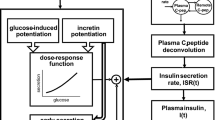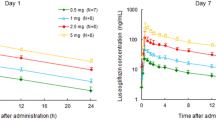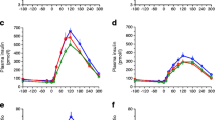Summary
Fifteen Type 2 diabetics were treated for 4-week periods with once daily (10 mg) glibenclamide, glipizide and placebo according to a double-blind cross-over protocol. Post-dose glipizide concentrations were three times higher than those of glibenclamide, due to the incomplete bioavailability of the latter. On the other hand, pre-dose drug levels were similar, as an expression of the slower absorption and/or elimination of glibenclamide. Both active treatments reduced postprandial blood glucose concentrations and 24-hour urinary glucose excretion to a similar degree, but fasting blood glucose concentrations were slightly lower during glibenclamide treatment. Both active treatments enhanced fasting and postprandial insulin and C-peptide concentrations, the C-peptide response being greater after glipizide than after glibenclamide. Plasma glucagon and GIP concentrations were not significantly affected. Insulin sensitivity was increased by glibenclamide but not by glipizide. Neither therapy affected insulin binding to erythrocytes. It appears that both glibenclamide and glipizide improved glucose metabolism by sustained stimulation of insulin secretion, which was most pronounced with glipizide. Only glibenclamide improved insulin sensitivity and was slightly more active than glipizide on fasting blood glucose levels. The differences may be consequences of the pharmacokinetics, but differences in pharmacodynamics cannot be excluded.
Similar content being viewed by others
References
Loubatieres A (1957) The hypoglycemic sulfonamides: history and development of the problem from 1942 to 1945. Ann NY Acad Sci 71: 4–11
Reaven GM, Dray J (1967) Effect of chlorpropamide on serum glucose and immunoreactive insulin concentrations in patients with maturity onset diabetes mellitus. Diabetes 16: 487–492
Shenfield GM, Logan A, Shirling D, Baird J (1977) Plasma insulin and glucose levels in maturity onset diabetes treated with chlorpropamide. Diabetologia 13: 367–371
Feldman JM, Lebovitz HE (1969) Appraisal of the extra-pancreatic actions of sulfonylureas. Arch Intern Med 123: 314–322
Marshall A, Gingerich RL, Wright PH (1970) Hepatic effect of sulfonylureas. Metabolism 19: 1046–1052
Olefsky JM, Reaven GM (1976) Effects of sulfonylurea therapy on insulin binding on mononuclear leucocytes of diabetic patients. Am J Med 60: 80–95
Feinglos MN, Lebovitz HE (1978) Sulphonylureas increase the number of insulin receptors. Nature 276: 184–185
Beck-Nielsen H, Pedersen O, Lindskov NO (1979) Increased insulin sensitivity and cellular insulin binding in obese diabetics following treatment with glibenclamide. Acta Endocrinol 90: 451–462
Lebovitz HE, Feinglos MN, Bucholtz HK, Lebovitz FL (1977) Potentiation of insulin action: a probable mechanism for the antidiabetic action of sulfonylurea drugs. J Clin Endocrinol Metab 45: 601–604
Greenfield MS, Doberne L, Rosenthal M, Schultz B, Widström A, Reaven GM (1982) Effect of sulfonylurea treatment on in vivo insulin secretion and action in patients with non-insulin dependent diabetes mellitus. Diabetes 31: 307–312
Creutzfeldt W, Ebert R (1977) Release of gastric inhibitory polypeptide (GIP) to a test meal under normal and pathological conditions in man. In: Bajaj JS (ed) Diabetes. Excerpta Medica 63, Amsterdam
Samols E, Tyler JM, Mialhe P (1969) Suppression of pancreatic glucagon release by the hypoglycemic sulphonylureas. Lancet 1: 174–176
Tsalikian E, Dunphy TW, Bohannon NV, Lorenzi M, Gerich JE, Forsham PH, Kane JP, Karam JH (1977) The effect of chronic oral antidiabetic therapy on insulin and glucagon responses to a meal. Diabetes 26: 314–321
Balant L (1981) Clinical pharmacokinetics of sulphonylurea hypoglycaemic drugs. Clin Pharmacokinet 6: 215–241
Jackson EJ, Bressler R (1981) Clinical pharmacology of sulphonylurea hypoglycaemic agents, part 1. Drugs 22: 211–245
Jackson EJ, Bressler R (1981) Clinical pharmacology of sulphonylurea hypoglycaemic agents, part 2. Drugs 22: 295–320
Wåhlin-Boll E, Melander A, Sartor G, Scherstén B (1980) Influence of food intake of the absorption and effect of glipizide in diabetics and in healthy subjects. Eur J Clin Pharmacol 18: 279–283
Sartor G, Lundquist I, Melander A, Scherstén B, Wåhlin-Boll E (1982) Improved effect of glibenclamide on administration before breakfast. Eur J Clin Pharmacol 21: 403–408
Herbert V, Gottlieb CW, Bleicher SJ (1965) Coated charcoal immunoassay of insulin. J Clin Endocrinol 25: 1375–1384
Kuzuya T, Matsuda A, Saito T, Yoshida S (1976) Human Cpeptide immunoreactivity (CPR) in blood and urine — evaluation of a radioimmunoassay method and its clinical applications. Diabetologia 12: 511–518
Unger RH, Eisentraut AM, McCall MS, Madison LL (1961) Glucagon antibodies and an immunoassay for glucagon. J Clin Invest 40: 1280–1289
Wåhlin-Boll E, Melander A (1979) High-performance liquid chromatographic determination of glipizide and some other sulfonylurea drugs in serum. J Chromatogr 164: 541–546
Alford FP, Martin FIP, Pearson MJ (1971) The significance of interpretation of mildly abnormal oral glucose tolerance. Diabetologia 7: 173–180
Gambhir KK, Archer JA, Bradley CJ (1978) Characteristics of human erythrocyte insulin receptors. Diabetes 27: 701–708
Dixon WJ (ed) BMDP statistical software 1981. University of Berkeley, California Press, 1981
Wåhlin-Boll E, Almér L-O, Melander A (1982) Bioavailability, pharmacokinetics and effects of glipizide in Type 2 diabetics. Clin Pharmacokinet 7: 363–372
Groop L, Harno K (1980) Diurnal pattern of plasma insulin and blood glucose during glibenclamide and glipizide therapy in elderly diabetics. Acta Endocrinol 94 [Suppl 239]: 44–52
Faber OK, Hagen C, Binder C, Markussen J, Naithani VK, Blix PM, Kuzuya H, Horowitz DL, Rubenstein AH, Rosing N (1978) Kinetics of human connecting peptide in normal and diabetic subjects. J Clin Invest 62: 197–203
Almér L-O, Johansson E, Melander A, Wåhlin-Boll E (1982) Influence of sulfonylureas on the secretion, disposal and effect of insulin. Eur J Clin Pharmacol 22: 27–32
Zermatten A, Heptner W, Delaloye B, Séchaud R, Felber J-P (1977) Extrapancreatic effects of glibenclamide: stimulation of duodenal insulin-releasing activity (DIRA) in man. Diabetologia 13: 85–88
Dupré J, Ross S, Watson D, Brown JC (1973) Stimulation of insulin secretion by gastric inhibitory polypeptide in man. J Clin Endocrinol Metab 37: 826–828
DeFronzo RA, Ferrannini E, Koivisto V (1983) New concepts in the pathogenesis and treatment of noninsulin dependent diabetes mellitus. In: Reaven GM (ed) Proceedings of a symposium. The role of insulin resistance in the pathogenesis and treatment of noninsulin dependent diabetes. Am J Med 74: pp 52–71
Maloff BL, Lockwood DH (1981) In vitro effects of a sulfonylurea on insulin action in adipoocytes. Potentation of insulinstimulated hexose transport. J Clin Invest 68: 85–90
Wåhlin-Boll E, Sartor G, Melander A, Scherstén B (1982) Impaired effect of sulfonylurea following increased dosage. Eur J Clin Pharmacol 22: 21–25
Putram WS, Andersen DK, Jores RS, Lebovitz HE (1981) Selective potentation of insulin-mediated glucose disposal in normal dogs by the sulfonylurea glipizide. J Clin Invest 57: 1016–1023
Author information
Authors and Affiliations
Rights and permissions
About this article
Cite this article
Groop, L., Wåhlin-Boll, E., Groop, P.H. et al. Pharmacokinetics and metabolic effects of glibenclamide and glipizide in type 2 diabetics. Eur J Clin Pharmacol 28, 697–704 (1985). https://doi.org/10.1007/BF00607919
Received:
Accepted:
Issue Date:
DOI: https://doi.org/10.1007/BF00607919




